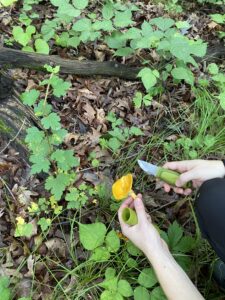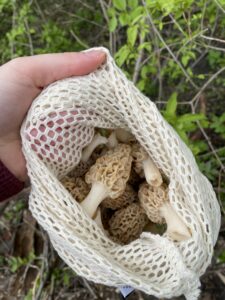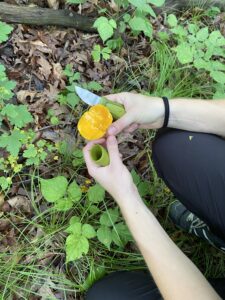
We’ve put together a brief foraging guide, to help you get started.
FORAGING
Foraging has risen in popularity over the last decade, especially in Scandinavia where New Nordic Cuisine shines a light on hyper seasonal and local food. Aside from rare plants and large scale chopping of trees or branches, the Swedish forests and meadows are open to anyone to find their own food.
The number one rule of foraging – always worth repeating – do not eat anything unless you are certain of what it is. Many berries and mushrooms are poisonous to humans and look like other fruits. During summer in Scandinavia, you might find lingonberries, blueberries, raspberries, strawberries, evening primrose, bishop’s lace, sorrel, cep mushrooms and more.
Foraging is a tradition that is intended to honor the land, and originates in Native American and indigenous cultures. Don’t take more than you need, and don’t take everything you find. See more in this video about the “Honorable Harvest” –

Shop foraging here!
LOCAL FARE
Here in Minnesota, nothing is in bloom quite yet. But soon rhubarb will pop up in many backyards. Other late spring and early summer finds include mushrooms like morels, fiddlehead ferns, and ramps. Throughout the summer come berries, milkweed pods and more that can be found on public lands and even in urban environments. See this blog on urban foraging.
Things to consider while foraging:
- Park laws; “public parks” does not mean a free for all when it comes to picking fruits, nuts, and leaves in the Twin Cities. Saint Paul prohibits picking in public parks, but Minneapolis has recently changed it’s laws on this, as long as your foraging is not for commercial use. You can get ticketed if you pick in prohibited areas, so make sure to look up where you plan to go beforehand.
- Contamination; water and run-off can be an issue as well as air pollution. Make sure to thoroughly wash any urban finds, peel roots, and be selective about leafy greens.
- Private property; of course you need explicit permission to pick plants on any private property, even if it’s a common weed!
A local organization, Four Season Foraging, teaches workshops on urban foraging here in the Twin Cities. You can find more resources that go more in depth than this foraging guide, on her site. 
Packing List
- It’s always handy to have a knife with you for clean cutting and root preservation. We recommend the Mora Eldris knife because of its compact size and safety sheath.
- A bag or basket – using a porous container has several purposes: free flowing air will keep your finds from wilting or getting too warm in a contained space, also if you are picking mushrooms, a mesh bag or open basket with holes will allow your cut mushrooms to continue to spread their spores throughout the area, helping grow future fungi.
- Guidebook, having a reference book with you could be the difference between life or death. Make sure you know what you are picking, and do not eat anything unless you are one hundred percent certain about the identification. It is best to go in with some of this knowledge already under your belt, so that you don’t unnecessarily pick and disturb inedible plants.
- A first aid kit is a must, just in case you meet a bit of nature that doesn’t agree with you, like a stinging nettle or sharp branch. Sunscreen can go along with this.
- Pack water and snacks, especially if you are walking in a new area you don’t know well.
- As far as clothing is concerned, make sure your legs and ankles are covered, just in case you brush up against something sharp or poisonous. And always pack layers! Weather often changes unexpectedly and temperatures can vary in the sun and shade.
You can find all things foraging on our website here. Thanks for reading our mini foraging guide!
All photo credit: Laila Simon.